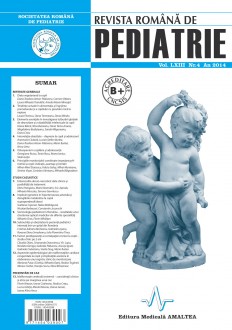SELECT ISSUE

Indexed

| |

|
|
|
| |
|
|
|

|
|
|
|
|
|
|
HIGHLIGHTS
National Awards “Science and Research”
NEW! RJP has announced the annually National Award for "Science and Research" for the best scientific articles published throughout the year in the official journal.
Read the Recommendations for the Conduct, Reporting, Editing, and Publication of Scholarly work in Medical Journals.
The published medical research literature is a global public good. Medical journal editors have a social responsibility to promote global health by publishing, whenever possible, research that furthers health worldwide.
PRINCIPLES OF COMBINED ESOPHAGEAL IMPEDANCE-PH MONITORING IN CHILDREN: INDICATIONS, BENEFITS AND LIMITATIONS
Mihai-Mirel Stoicescu, Felicia Galos, Mihai Munteanu, Simina Visan, Coriolan Ulmeanu and Mihaela Balgradean
ABSTRACT
The standard test for suspected gastroesophageal reflux is pH monitoring. However, the majority of gastroesophageal reflux episodes in infants and children are nonacidic (pH > 4) and extraesophageal symptoms apparently can be caused by both acidic (pH < 4) and nonacidic reflux. In order to overcome these aspects, a new technique has been developed and placed under scrutiny in the past twenty years: multichannel intraluminal impedance. Combined with standard pH recording, it provides more information than simple pH measurement because it allows the study of non-acid reflux and the temporal association between symptoms and nonacid reflux. Data can be analyzed for bolus composition (gas, fluid, solid) and reflux height, duration, and clearance. Although normal values for the pediatric population are not yet available, combined multichannel intraluminal impedance and pH measurement has the potential to become the new “gold standard” for gastroesophageal reflux testing
Keywords: children, adolescents, gastroesophageal reflux, esophageal impedance, esophageal pH monitoring, combined esophageal impedance-pH monitoring, esophagus, gastroesophageal reflux, diagnosis, medical
